Today in History: May 23
When Johnny comes Marching Home Again, Hurrah, hurrah!
We'll give him a hearty welcome then, Hurrah, hurrah!
The men will cheer, the boys will shout, The ladies, they will all turn out,
And we'll all feel gay, When Johnny comes marching home"When Johnny Comes Marching Home; Soldier's Return March,"
words and music by Louis Lambert (pseudonym of Patrick Sarsfield Gilmore), 1863.
Historic American Sheet Music, 1850-1920
On May 23, 1865, the Army of the Potomac celebrated the end of the Civil War by parading down Pennsylvania Avenue in Washington, DC. Only weeks before, mourners watched Abraham Lincoln's funeral cortege travel the same thoroughfare. With many buildings still dressed in black crepe, this joyous procession could not help but remind spectators of that unhappy occasion.
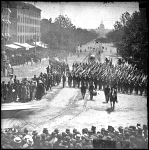
Infantry Unit, Pennsylvania Avenue, Washington, D.C.,
Mathew B. Brady, photographer, 1865.
Civil War Photographs, 1861-1865
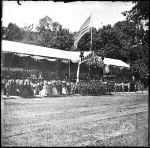
Presidential Reviewing Stand, Grand Review of the Army, Washington, D.C.,
Mathew B. Brady, photographer, 1865.
Civil War Photographs, 1861-1865
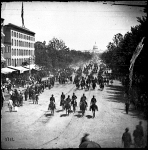
Artillery Unit, Pennsylvania Avenue, Washington, D.C.,
Mathew B. Brady, photographer, 1865.
Civil War Photographs, 1861-1865
Laid out by Pierre L'Enfant, Pennsylvania Avenue was one of the earliest streets constructed in the federal city. Both George Washington and Thomas Jefferson considered the Avenue an important feature of the new Capital. After inspecting L'Enfant's plan, President Washington referred to the thoroughfare as a "Grand Avenue." Jefferson concurred, and while the "grand avenue" was little more than a wide dirt road, he planted it with rows of fast growing Lombardy poplars.
Although Pennsylvania Avenue extends seven miles, the expanse between the White House and the Capitol constitutes the ceremonial heart of the nation. Washington called this stretch "most magnificent & most convenient" and it has served the country well. Ever since an impromptu procession formed around Jefferson's second inauguration, each United States president has paraded down the Avenue after taking the oath of office. From William Henry Harrison to John F. Kennedy the funeral corteges of the seven presidents who died in office followed this route.

President McKinley's Funeral Cortege at Washington, D.C.,
Thomas A. Edison, Inc., September 1901.
The Last Days of a President: Films of McKinley and the Pan-American Exposition
Not just the scene of official functions, Pennsylvania Avenue is the traditional parade and protest route of ordinary citizens. During the depression of the 1890s, for example, Jacob Coxey marched 500 supporters down Pennsylvania Avenue to the Capitol to demand Federal aid for the unemployed. Similarly, on the eve of Woodrow Wilson's 1913 inauguration, Alice Paul masterminded a parade highlighting the woman suffrage movement. In July 1932, a contingent of the Bonus Expeditionary Force carried flags down Pennsylvania Avenue to the White House where they planned to form picket lines. Pennsylvania Avenue also has served as a background for more lighthearted celebrations, including a series of day and nighttime Shriner's parades in the 1920s and 1930s.
Learn more about the nation's most historic thoroughfare:
- Fifteen photographs of the Grand Review of the Army, probably the work of Mathew Brady, are available in the collection Civil War Photographs, 1861-1865. Use the Time Line of the Civil War, 1865 to locate more images of the final days of the war.
- The collection The Last Days of a President: Films of McKinley and the Pan-American Exposition, 1901 contains film footage of McKinley's ride down Pennsylvania Avenue to the Capitol were he took the oath of office for the second time. The President's funeral cortege, also captured on film, made the same journey just six months later.
- Touring Turn-of-the-Century America: Photographs from the Detroit Publishing Company, 1880-1920 contains eleven photographs of Pennsylvania Avenue at the turn of the century. Compare these images with photographs by Theodor Horydczak taken in the 1930s and 1940s and available in Washington As It Was. Search each of these collections on Pennsylvania Avenue to access these pictures.
The New York Public Library
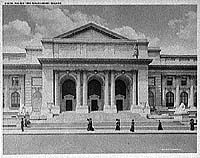
New York Public Library, New York, New York, between 1910 and 1920.
Touring Turn-of-the-Century America, 1880-1920
President William Howard Taft presided over the dedication of the New York Public Library on May 23, 1911. Between 30,000 and 50,000 visitors passed through the entrance hall on opening day.
Built on the site of the Croton Reservoir, the immense marble Beaux-Arts structure required a decade of preparation and construction. With room for exhibitions as well as a picture gallery, the New York Public Library was designed to meet a variety of educational needs. Strategically situated above seven floors of stacks, its main reading room provided researchers with requested materials as quickly as possible.
In 1886, former New York governor Samuel J. Tilden bequeathed $2.4 million for the creation of a free public reading room and library in New York City. Nearly ten years later, the Tilden Trust combined with two existing research institutions—the Lenox Library and the Astor Library—to form the New York Public Library. In addition to preserving Astor and Lenox holdings, the NYPL further served the reading public by consolidating with the New York Free Circulating Library and by managing the branch library system funded by philanthropist Andrew Carnegie.
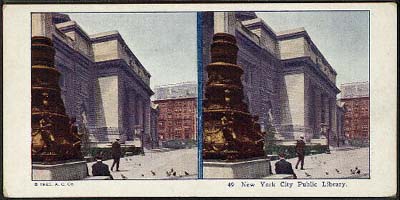
New York City Public Library, New York, New York, copyright 1925.
Small-Town America, 1850-1920
From American Life Histories, 1936-1940
In the spring of 1939, a writer employed by the Federal Writers' Project encountered an "habitué of the New York Public Library" among the City's "unemployed fringe." This "high-strung sidewalk intellectual" outlines his philosophy of life in "A One-Man Boycott of the Universe," an American Life Histories, 1936-1940 interview:
I am a student of life, I am a scholar of cosmos, my contemporary friend a scholar of cosmos. Cosmology, histology, pathology, neurology, astro-physiology and the whole tautology of existence are my fields. But what have I ascertained, deduced, induced, produced [?] Is there a design, a scheme, a plan in this world? No, I declare, no, no and again no. The world is tottering toward catastrophe, My friend, it is suffering endless fluctuations, alterations, transformations, - in short, flux…[W]hat keeps me from going mad? Why, words, my contemporary, just words."A One-Man Boycott of the Universe,"
Herman Partnow, interviewer, April 17, 1939.
American Life Histories, 1936-1940
Learn more about New York City and the New York Public Library:
- Visit the Web site of the New York Public Library to learn more about the Library's origins. See the feature on the Library Lions, "Patience" and "Fortitude." Plan to visit the New York Public Library's Digital Library Collections.
- See Small-Town America, 1850-1920 which includes 12,000 photographs of New York, New Jersey, and Connecticut: intended for stereoscopic viewing, these images are from the Robert Dennis Collection of the New York Public Library. The views show buildings and street scenes in cities, towns, and villages as well as natural landscapes. They also depict agriculture, industry, transportation, homes, businesses, local celebrations, natural disasters, people, and costumes.
- View film footage of the NYPL. Panorama from Times Building, New York, available through the collection Life of a City: New York, 1898-1906 provides a glimpse of the Library in 1905.
- Several Today in History pages focus on New York City institutions. Read features on the Metropolitan Opera House, Radio City Music Hall, and Central Park.
- American Memory contains nearly two hundred photographs of public libraries across the country; to explore this assemblage, search the collections of Photos & Prints on public library. To narrow your selection, add the name of a city or state, as in public library Norfolk.